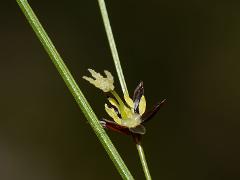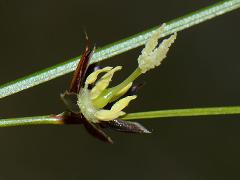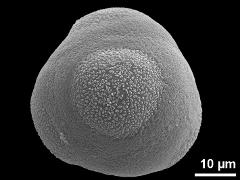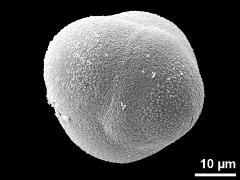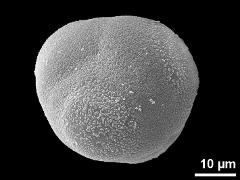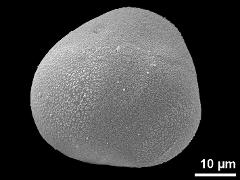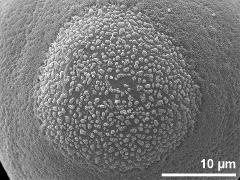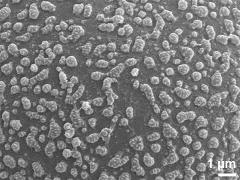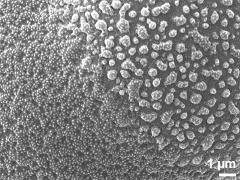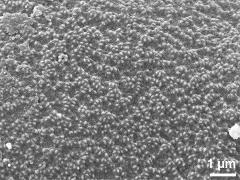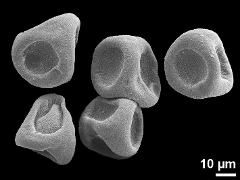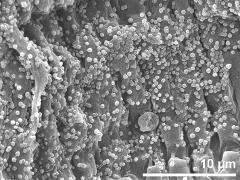Orejuncus monanthos
Taxonomy: Angiospermae, Poales, Juncaceae, Orejuncus
Published: 2019-12-19
Pollen Description
Shape, Size and Aperture
pollen unit: tetrad, dispersal unit and peculiarities: tetrad, size (pollen unit): medium-sized (26-50 µm), size of hydrated pollen (LM): -, shortest polar axis in equatorial view (LM): -, longest polar axis in equatorial view (LM): -, shortest diameter in equatorial or polar view (LM): -, longest diameter in equatorial or polar view (LM): -, pollen class: tetrad, polarity: heteropolar, P/E-ratio: -, shape: -, outline in polar view: circular, dominant orientation (LM): -, P/E-ratio (dry pollen): -, shape (dry pollen): cup-shaped, outline in polar view (dry pollen): circular, infoldings (dry pollen): aperture(s) sunken, aperture number: 1, aperture type: ulcus, aperture condition: ulcerate, aperture peculiarities: aperture membrane ornamented
Ornamentation and Structure
LM ornamentation LM: -, nexine: -, sexine: -, SEM ornamentation SEM: microverrucate, microechinate, suprasculpture SEM: -, TEM tectum: -, infratectum: -, foot layer: -, endexine: -, intine: -, wall peculiarities: -, supratectal element: -
Miscellaneous
pollen coatings: -, reserves in cytoplasm: -, cell number: -, Ubisch bodies: present
Author(s) of diagnosis: Halbritter, Heidemarie
Pictures
Picture legend
- inflorescence(s), photographer: Berger, A.
- inflorescence(s), photographer: Berger, A.
- tetrad, apical view - dry, rehydrated (water) & critical point dried & sputter coated with gold, photographer: Halbritter, H.
- tetrad, lateral view - dry, rehydrated (water) & critical point dried & sputter coated with gold, photographer: Halbritter, H.
- tetrad, basal view - dry, rehydrated (water) & critical point dried & sputter coated with gold, photographer: Halbritter, H.
- tetrad - dry, rehydrated (water) & critical point dried & sputter coated with gold, photographer: Halbritter, H.
- aperture - dry, rehydrated (water) & critical point dried & sputter coated with gold, photographer: Halbritter, H.
- aperture detail - dry, rehydrated (water) & critical point dried & sputter coated with gold, photographer: Halbritter, H.
- aperture detail - dry, rehydrated (water) & critical point dried & sputter coated with gold, photographer: Halbritter, H.
- exine surface - dry, rehydrated (water) & critical point dried & sputter coated with gold, photographer: Halbritter, H.
- dry pollen - dry, sputter coated with gold, photographer: Halbritter, H.
- Ubisch bodies on locule wall - dry, sputter coated with gold, photographer: Halbritter, H.
Literature
- (1998) Preparing living pollen material for scanning electron microscopy using 2,2-dimethoxypropane (DMP) and criticalpoint drying. Biotechnic Histochem 73: 137–143
- (2013) Oreojuncus, a new genus in the Juncaceae Preslia 85: 483-503
Copyright and Citation
Cite this publication as:
Halbritter H., Berger A. 2019. Orejuncus monanthos. In: PalDat - A palynological database. https://www.paldat.org/pub/Orejuncus_monanthos/303584;jsessionid=8F612233024F81975D95D50E0EC3A5F4; accessed 2025-10-20

